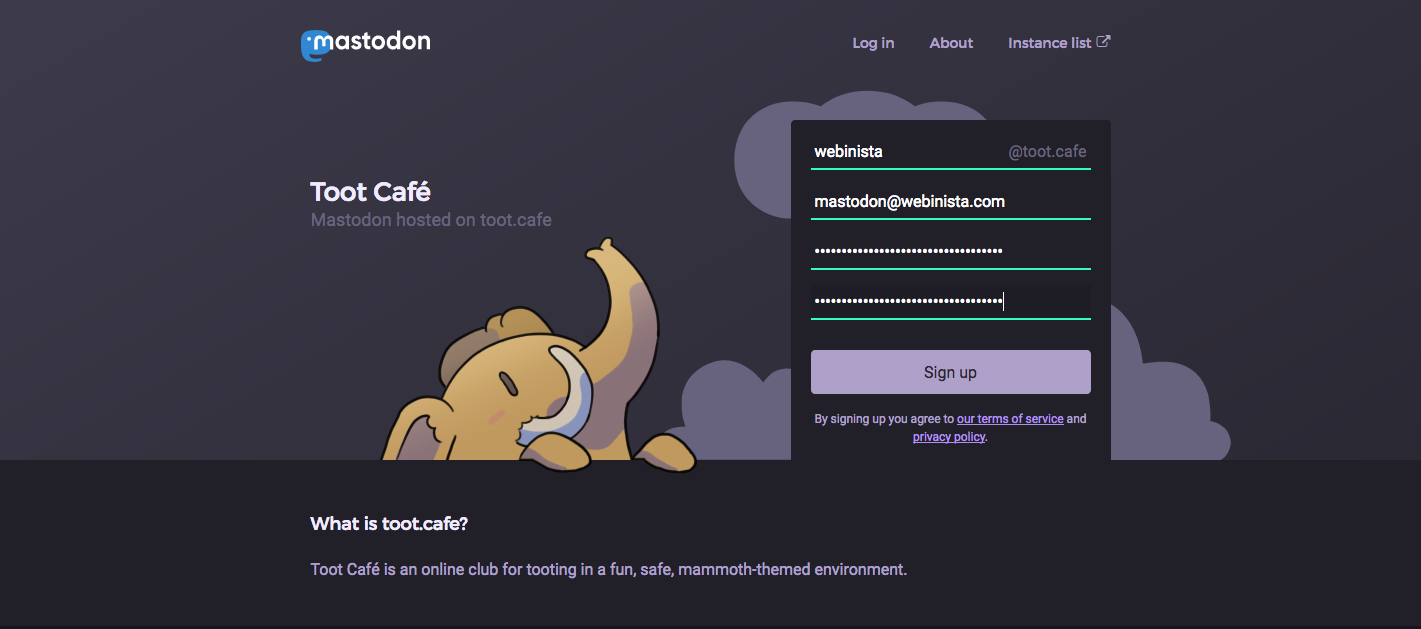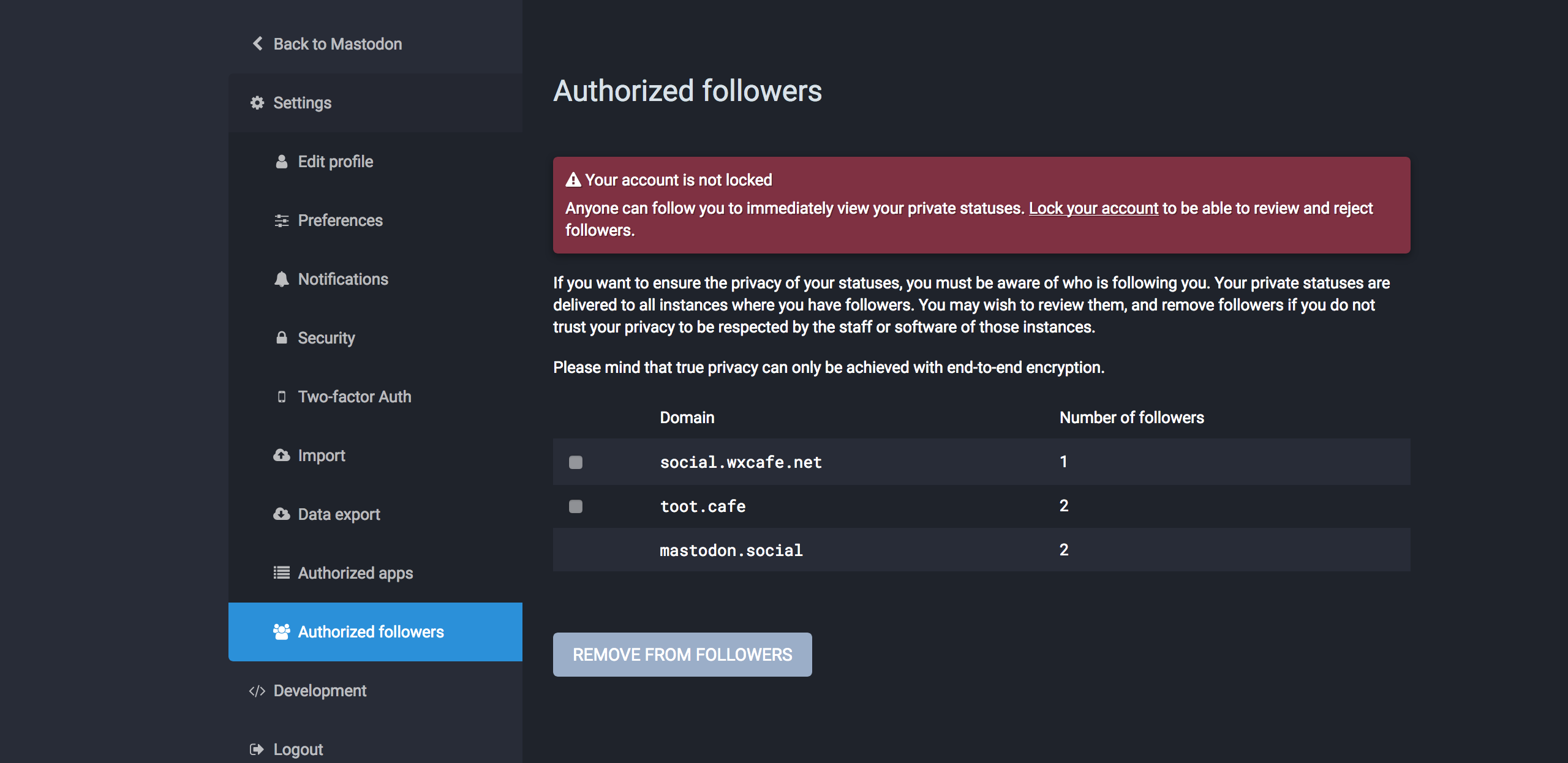Meet Mastodon
UPDATE: Noëlle Anthony also published a really great guide to Mastodon. It includes facets of Mastodon's culture that I did not cover here.
What’s Mastodon?
Mastodon describes itself as the world’s largest free, open-source, decentralized microblogging network.
In less nerdy terms, it’s a do-it-yourself Twitter.
Why use Mastodon?
Mastodon was created explicitly as an open source, non-commercial, decentralized alternative to Twitter. There are no ads1. Your timeline is in chronological order, not algorithmic order. It’s not designed to suck up all of your attention and sell it to advertisers.
Mastodon posts can be up to 500 characters long. It also has more robust privacy and anti-harassment tools. For example, a post can be:
- posted to public timelines;
- unlisted, or viewable publicly, but not posted to timelines;
- shown to followers only; or
- shown only to the users mentioned — somewhere between a Twitter @-message and a direct message.
As with Twitter, you can also mute, block, or report users. Unlike Twitter, you can also block content from an entire Mastodon instance.
Perhaps the best reason to use it is that you can find a community with moderation rules that you prefer. If you want one that’s as freewheeling as one of the *chans, you can find it. If you want one that will suspend neo-N#zis, you have plenty of options.
How do I get started?
Anyone can host a Mastodon instance (here's another guide). There’s even a managed instance hosting provider that will take care of server and software upgrades. Most people will find it easier to join an existing community.
Mastodon.social is the premier instance and one of the largest. It’s run by the lead developer of Mastodon. You do not have to join Mastodon.social in order to use Mastodon. But it’s a popular entry point.
Word-of-mouth is the best way to find an instance, aside from launching your own. For example, I joined Toot Café because I knew the administrator, Nolan Lawson, from Twitter. Dzuk, a Mastodon administrator maintains a list of instances that are well-behaved and well-moderated. Dzuk also maintains a blocklist advisory of instances to avoid. Find more instances at Instances.social.

Choose your instance carefully.
Before joining a Mastodon community, read that community’s About page. It’s where communities describe what behavior and content is allowed or prohibited. The best communities may also have a list of blocked Mastodon instances (see Toot Café’s) or a whitelist of trusted instances (see Awoo.Space’s).
Another reason to choose carefully: your instance name is part of your user name across the federated Mastodon network. For example, I’m part of Toot Café and mastodon.social. As a result, I have two user names2: @webinista@toot.cafe and @webinista@mastodon.social.
Think of your user name as more of an email-esque social media address. You can follow and @-message users across instances. If you try to follow a remote account — that is, an account on a different instance3 — you’ll be prompted to enter the user name and domain for your account before following.
Beware of malicious instances
I’d be remiss if I didn’t mention one of the dark sides of Mastodon: malicious instances. An instance may, for example:
- add JavaScript malware or intrusive tracking and analytics.
- alter Mastodon's code to break federation — or worse — ignore the privacy settings of a user or post.
- be a nation-state backed or hostile, non-state influence operation.
For example, @Sir_Boops noticed that Mastodon.host was serving JavaScript that mined cryptocurrency in visitors’ browsers. Miners are so resource intensive that they're generally considered a form of malware.
Mastodon delivers content between instances. If I follow a member of witches.town, toot.cafe copies that member's posts to its servers. Deleting a post on one instance notifies other instances that they should delete their copies. But what if they don’t?
A malicious instance could alter Mastodon’s code to retain copies of posts or ignore a post’s visibility settings. Locking your account mitigates this by delivering content only to users on instances you've approved, but may not eliminate the risk. Find these controls under Edit profile → Authorized followers (see Figure 2).

Note: a screen shot or database breach can make your privacy settings moot. That's true for the internet in general. Use good judgment about what you publish.
There’s not much recourse against malicious instances beyond blocking them. Members can do that individually. Instance administrators can do so for all of its users. Word-of-mouth can help you avoid malicious instances in the first place.
Local versus federated timelines
Mastodon’s UI resembles Tweetdeck. There’s a text input column followed by a Home column (people you follow) and a notifications column.
In the last column, things get a little confusing. It’s a navigation column, but it’s also where you can view the Local and Federated timelines. The Local timeline consists of public posts from your Mastodon instance. The Federated timeline consists of public posts by Mastodon users that members of your instance follow.
Mastodon lingo
Mastodon is modeled on Twitter, but it has its own lingo.
- Mastodon posts are called toots.
- You click a star icon to favourite a toot.
- Reposts are known as boosts.
- Instead of the Twittersphere or Twitterverse, it’s the Fediverse.
In the Mastodon world, Twitter has a nickname too: it’s known as (the) birdsite.
I think I’m ready to quit (the) birdsite!
Great! Twitter is a time suck with a neo-N#zi problem. But before you leave, there are some issues to consider.
-
Mastodon’s communities are diffuse, smaller, and may be less active. If you have a lot of conversations on Twitter, you’ll get fewer of them on Mastodon.
-
There’s no Who to follow engine. You’ll have to do that work. As with any nascent social network, your friends may not be there yet. Mastodon Bridge will help you find Twitter friends on the network. Or search / post to the
#introductionor#introductionshash tags. -
Instances can be ephemeral. Administrators may close registrations once the community or site consumes too much time or money. Some instances go as far as to limit registrations to particular days and hours.
-
Most instances are supported by donations. Your favorite community could well disappear if the server costs or time spent moderating exceed the budget or willingness of the administrator. Contribute if you can.
-
Mastodon development itself is supported by donations and community volunteers. If Garagon can no longer survive off of Patreon contributions, Mastodon development could slow or cease. Again: contribute if you can.
-
Jerks, trolls, and big fat poopy-heads can be found in the ‘Fediverse’ too. Flame wars, cultural battles, and harassing pile-ons — the discourse in Mastodon lingo — can happen across instances. Malicious users can impersonate known personalities or entities.
For more context on the challenges of Mastodon and the fediverse, I recommend the following articles.
- Nolan’s What is Mastodon and why is it better than Twitter; and
- Lance Ulanoff’s Don’t get too attached: Twitter ’rival’ Mastodon will go extinct
I’ve used Mastodon since the beginning of this month (December 2017). It feels like a throwback to a weird and more independent internet. The fediverse isn’t perfect, but its granular controls and distrubted nature give you the tools to create a less toxic social networking experience.
This is the first of a three-part series. You may also like my follow-up posts Privacy on Mastodon and Mastodon Tools.
Trumpet sound courtesy of profcalla.
-
Mastodon doesn’t have ads by default, but there’s nothing to prohibit an administrator from launching an ad-supported instance. ↩
-
As of Mastodon 2.1, you can link your first profile to another. Visitors to your profile page will see a small notice that “[Your user name] has moved to [new instance],” e.g. “Webinista has moved to toot.cafe.” Mastodon also lets you export and re-import your data. ↩
-
If an instance has been banned by your instances’ administrators, you can’t follow any of those users from your account. This prevents content from those instances from showing up on the federated timeline. ↩